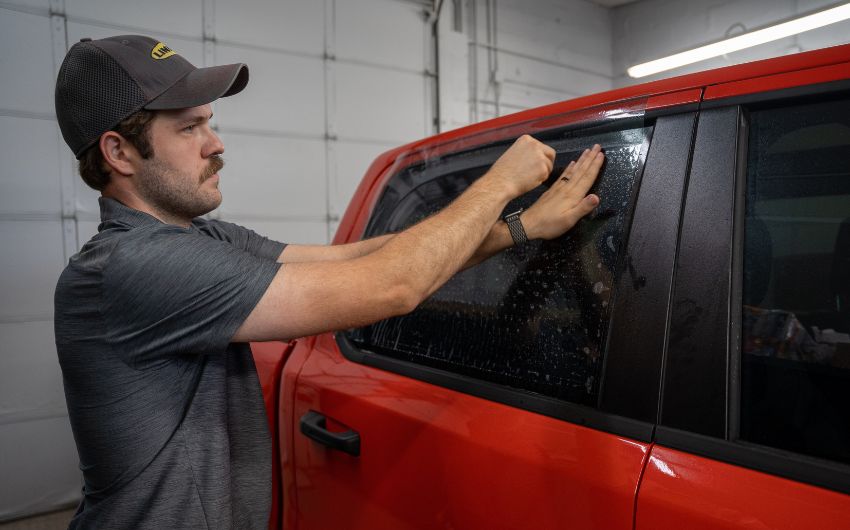Vehicle Window Tinting for Warm Decrease and Power Effectiveness
Vehicle Window Tinting for Warm Decrease and Power Effectiveness
Blog Article
Home Window Tinting Regulations and Guidelines: What You Need to Know Prior To Tinting Your Automobile
Prior to waging home window tinting for your car, it is necessary to acquaint yourself with the diverse legislations and standards that govern this method throughout different states. These laws determine the permitted levels of tint darkness, often measured by noticeable light transmission (VLT) portions, and consist of certain specifications for front windscreens intended at ensuring road safety and security. Additionally, particular jurisdictions may use medical exceptions for individuals with certifying conditions. Recognizing these complexities can conserve you from potential lawful ramifications, but what are the specific guidelines in your state?
Introduction of Window Tinting Rules
Home window tinting laws are regularly subject to variation across different jurisdictions, mirroring local policies and safety factors to consider. These legislations determine the acceptable degrees of tint darkness and reflectiveness on lorry home windows, making sure that motorists keep adequate visibility while also protecting against harmful UV rays and heat.
A lot of laws identify window tinting based upon the Visible Light Transmission (VLT) percent, which indicates the quantity of light that can go through the window. Typically, lower VLT percentages indicate darker colors. Regulations usually differentiate between the front, side, and rear windows, with more stringent restrictions put on the front windscreen to enhance safety for both the driver and other road customers.
Compliance with window tinting regulations is crucial, as violations can result in penalties, obligatory elimination of the tint, and possible rises in insurance coverage costs. It is important for car owners to familiarize themselves with local regulations before continuing with window tinting setups.
State-by-State Tint Rules
Comprehending the certain window tinting regulations in each state is vital for vehicle owners looking for to adhere to the regulation. Each state in the united state has developed its own collection of guidelines controling window tinting, which can vary significantly. These laws often dictate the allowed levels of tint darkness, the kinds of windows that can be tinted, and any medical exemptions that might apply.
For instance, states like California have rigid constraints on color darkness for front home windows, while others, such as New Mexico, may enable darker colors. In addition, certain states mandate certain visibility portions for numerous home windows, including the windscreen, front side home windows, and back windows. It is critical for car proprietors to acquaint themselves with their state's laws to avoid possible fines or penalties.
Furthermore, some states may require an accreditation sticker label to be put on colored home windows, indicating conformity with state regulations. Failing to comply with these guidelines not only takes the chance of legal effects yet can also impact security and presence while driving. Lorry owners ought to carry out complete research or speak with neighborhood authorities to guarantee complete understanding and conformity with state-by-state color laws.
Allowed Tint Kinds and degrees
Numerous vehicle proprietors may be stunned to discover that allowed color degrees and types differ commonly throughout different states. Each state has established its very own laws pertaining to the acceptable darkness and reflectivity of window tint, commonly gauged by Visible Light Transmission (VLT) percents. VLT describes the quantity of light that can go through the colored home windows; therefore, a reduced percentage suggests a darker tint.

Furthermore, the kinds of tint products permitted can differ, with some states prohibiting mirror-like or metal coatings. It is vital for automobile proprietors to acquaint themselves with their state's particular legislations to guarantee conformity. Non-compliance can result in penalties, mandatory elimination of the color, or various other legal consequences, making it crucial to understand these laws prior to proceeding with installment.
Medical Exceptions for Tinting
While not all states give allocations for medical exemptions regarding window tinting, those that do recognize the need for specific people to improve exposure and comfort because of medical conditions. Various clinical conditions, such as lupus, skin cancer cells, and certain eye problems, can provide individuals particularly sensitive to sunshine. Consequently, these people may need darker colors to shield themselves from unsafe UV rays and glow.

It is essential to note that despite having a medical exemption, there may click resources still be constraints on the degree of color enabled. Compliance with state laws guarantees that individuals are both protected and within legal limitations. Those thinking about clinical exceptions need to call their local Division of Electric motor Autos or comparable authority to understand the demands and procedures essential to use for an exemption efficiently.
Charges for Non-Compliance
Stopping working to abide by window tinting laws can lead to substantial penalties, which differ by state. Legislation enforcement agencies are equipped to issue citations for automobiles that do not stick to the specified tinting regulations. These fines typically include penalties, which can range from modest total up to numerous hundred dollars, depending upon the seriousness of the violation and the state in question.
In some territories, duplicated offenses may cause rising penalties or added charges, such as required court looks. Furthermore, non-compliance may demand the removal of illegal tinting, typically at the proprietor's expenditure. In severe situations, regular culprits may deal with suspension of their vehicle enrollment till compliance is achieved.
Furthermore, insurance policy implications might emerge from obtaining multiple citations for home window tint infractions. Insurance companies might see such offenses as a sign of riskier habits, possibly resulting in enhanced premiums or problem in insurance coverage.
To stay clear of these charges, it is crucial for automobile proprietors to acquaint themselves with their local window tinting legislations and make sure website here that their car complies (Window Tinting). This aggressive strategy not just avoids lawful ramifications however also advertises roadway security
Conclusion

The majority of guidelines classify window tinting based on the Visible Light Transmission (VLT) percent, which indicates the amount of light that can pass through the window. Conformity with window tinting laws is crucial, as violations can result in fines, obligatory removal of the tint, and prospective increases in insurance policy costs.Recognizing the certain home window tinting regulations in each state is important for lorry proprietors looking for to abide with the regulation. These guidelines usually determine the allowable degrees of color darkness, the kinds of home windows that can be tinted, and any kind of clinical exemptions that might use.
For circumstances, states like The golden state have rigorous limitations on color darkness for front windows, while others, such as New Mexico, may permit darker colors.
Report this page